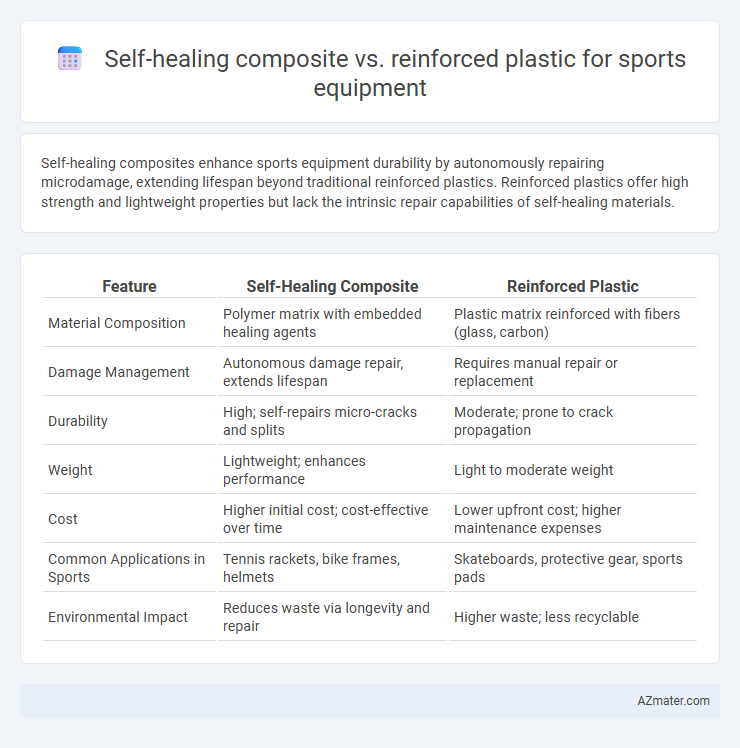Self-healing composites enhance sports equipment durability by autonomously repairing microdamage, extending lifespan beyond traditional reinforced plastics. Reinforced plastics offer high strength and lightweight properties but lack the intrinsic repair capabilities of self-healing materials.
Table of Comparison
| Feature | Self-Healing Composite | Reinforced Plastic |
|---|---|---|
| Material Composition | Polymer matrix with embedded healing agents | Plastic matrix reinforced with fibers (glass, carbon) |
| Damage Management | Autonomous damage repair, extends lifespan | Requires manual repair or replacement |
| Durability | High; self-repairs micro-cracks and splits | Moderate; prone to crack propagation |
| Weight | Lightweight; enhances performance | Light to moderate weight |
| Cost | Higher initial cost; cost-effective over time | Lower upfront cost; higher maintenance expenses |
| Common Applications in Sports | Tennis rackets, bike frames, helmets | Skateboards, protective gear, sports pads |
| Environmental Impact | Reduces waste via longevity and repair | Higher waste; less recyclable |
Introduction to Advanced Materials in Sports Equipment
Self-healing composites represent a cutting-edge advancement in sports equipment, offering enhanced durability by autonomously repairing micro-cracks and damage, which extends the lifespan of gear compared to traditional reinforced plastics. Reinforced plastics, composed of polymers combined with fibers like carbon or glass, provide high strength-to-weight ratios essential for performance but lack the ability to self-repair. The integration of self-healing composites in sports equipment revolutionizes material performance, reducing maintenance needs and improving safety through sustained structural integrity.
Overview of Self-Healing Composite Technologies
Self-healing composite technologies in sports equipment leverage microcapsules, vascular networks, and intrinsic polymer matrices to autonomously repair damage, enhancing durability and lifespan compared to traditional reinforced plastics. These composites incorporate materials like thermosetting resins embedded with healing agents that activate upon crack formation, restoring mechanical integrity without manual intervention. The integration of self-healing features addresses common wear issues in sports gear, providing superior resistance to impact and fatigue relative to conventional reinforced plastic components.
What Are Reinforced Plastics? Key Features and Applications
Reinforced plastics are composite materials made by combining a polymer matrix with reinforcing fibers such as glass, carbon, or aramid, enhancing mechanical strength and durability. Key features include high strength-to-weight ratio, corrosion resistance, and excellent fatigue performance, making them ideal for demanding sports equipment like helmets, tennis rackets, and bicycle frames. Their versatility and ability to withstand dynamic loads ensure improved athlete safety and performance across various sporting disciplines.
Comparative Mechanical Strength: Self-Healing Composite vs Reinforced Plastic
Self-healing composites exhibit superior mechanical strength compared to traditional reinforced plastics, with enhanced impact resistance and durability thanks to their autonomous damage repair mechanisms. Reinforced plastics, while strong and lightweight, often suffer from reduced longevity due to irreversible micro-cracks and fatigue under repeated stress. The integration of self-healing agents within composite matrices significantly improves structural integrity and extends the lifespan of sports equipment under dynamic loading conditions.
Impact Resistance and Durability in Sports Use
Self-healing composites exhibit superior impact resistance by autonomously repairing micro-cracks and minor damages, significantly extending the lifespan of sports equipment under repetitive stress. Reinforced plastics, while durable and strong, lack the intrinsic ability to recover from impacts, leading to gradual degradation and reduced performance. The advanced durability and maintenance-free nature of self-healing composites make them highly advantageous for high-impact sports applications requiring long-term reliability.
Weight and Flexibility Considerations for Athletes
Self-healing composites offer superior flexibility and reduced weight compared to traditional reinforced plastics, enhancing athletic performance by allowing more natural movement and reducing fatigue. The lightweight nature of self-healing materials minimizes the overall equipment mass, directly benefiting endurance and agility in sports. Reinforced plastics, while durable, often add bulk and restrict flexibility, making self-healing composites a preferred choice for high-performance sports gear where weight and flexibility are critical.
Maintenance, Repair, and Lifespan Differences
Self-healing composites in sports equipment significantly reduce maintenance needs by autonomously repairing micro-cracks, extending overall lifespan compared to reinforced plastics that require manual repair after damage. Reinforced plastics often suffer from cumulative wear and tear leading to frequent inspections and component replacements, increasing downtime and costs. The inherent damage resistance and repair capabilities of self-healing composites ensure longer durability and consistent performance in high-impact sports applications.
Cost Analysis: Initial Investment vs Long-Term Value
Self-healing composites typically require a higher initial investment than reinforced plastics due to advanced material technology and manufacturing processes. Over time, the ability of self-healing composites to autonomously repair micro-damages reduces maintenance costs and extends the lifespan of sports equipment, resulting in a lower total cost of ownership. Reinforced plastics may be more affordable upfront but often incur higher long-term expenses due to frequent repairs or replacements, impacting overall value.
Environmental Impact and Sustainability of Both Materials
Self-healing composites in sports equipment offer enhanced sustainability by significantly reducing waste and extending product lifespan through autonomous damage repair, which minimizes the need for frequent replacements. Reinforced plastics, while strong and lightweight, often rely on non-biodegradable polymers and energy-intensive manufacturing processes that contribute to environmental pollution and pose challenges in recycling. The environmental impact of self-healing composites is generally lower due to their potential for circularity and longevity, making them a more eco-friendly choice compared to traditional reinforced plastics in sustainable sports equipment design.
Future Trends and Innovations in Sports Equipment Materials
Self-healing composites in sports equipment offer advanced durability by autonomously repairing micro-cracks, extending product lifespan beyond traditional reinforced plastics. Innovations in nano-engineering and bio-inspired polymers are driving the development of smart materials that adapt to stress and environmental conditions, outperforming conventional reinforced plastics in impact resistance and flexibility. Future trends emphasize integrating self-healing capabilities with lightweight composites to enhance athlete performance and safety without compromising material sustainability.

Infographic: Self-healing composite vs Reinforced plastic for Sports equipment
 azmater.com
azmater.com